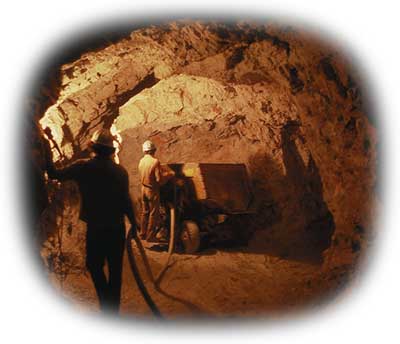

Mining is the process of extracting minerals and geological materials from the earth, and these materials include removing ores, veins, and soils. This operation supports 14.4 percent of the world’s total economy, while using less than 1 percent of the global surface area (CIA World Factbook). Thus mining, which encompasses excavating for oil, precious stones, precious metals, water, and natural gas is an extremely profitable and globally efficacious industry. However, though mining assists the world economy, it also severely thwarts the world's struggling biodiversity. All mining negatively affects biodiversity because the process breaks down the earth's surface, while chemically altering environments (Coal Combustion: Nuclear Research or Danger). Mining work often goes unregulated, causing endangered lives, lack of pollution control, and occasional rockslides that negatively affect communities around the world.
 |
Mining negatively affects biodiversity, but often times it is the only possible way for survival in many developing countries With the election of Peru's 97th President, Ollanta Humala, the gold prices have spiked, and are currently nearing 2,000 USD per ounce, and Peru is a very resourceful location for gold excavation. Due to this high price, many struggling citizens are resorting to unregulated mining for gold, and this puts the environment in direct exposure to fatal toxins, which are illegal in international mining legislation (Peru's Unregulated Mining Sector, Unregulated Small Mining Operations).
Mining leaves a massive environmental footprint, because of how it is immersed within different an environment around the world, and thus it heavily affects its surrounding areas. Examples of the environmental impacts of mining include habitat erosion, soil contamination, and water contamination.
Habitat erosion is one prevalent effect of mining. Hillsides are often removed and never replaced, and dynamite mining creates many subterranean holes (Mountaintop Removal Mining in West Virginia). In West Virginia, a heavy coal mining area, 20-25 percent of the coal excavation in the state is done through mountaintop methods, which erode and permanently alter the local habitats. This type of mining is very effective for coal, because coal beds are set in multiple layers, and many of these are situated at the top. Thus coal can be excavated efficiently through mountaintop mining because of the integrated coal layers within mountains. The after-effects of mining are supposed to be restored back to original condition after excavation, but these rules are often not enforced by officials nor followed by mining companies. Examples of this include most Middle and Southern African countries during the 1990's and 2000's era,w here the governments practiced deregulation. Two countries that are notable for having unenforced legislation is Mali and Madagascar from 1999 into the 21st century. Both of these countries suffered from having a decentralized and insufficiently funded government that could not enforce its legislation, so mining left the habitats in shambles following the excavations (The Challenges of Development, Mining Codes in Africa And Corporate Responsibilities).
The final major complication associated with mining is the chemical effects on the water and soil from the mining operations. People often do not purify water prior to consumption, and so these chemicals cause fauna and flora to struggle because of the lack of clean water. Mining produces chemical imbalances in the water when poorly built roles have sediment that enters the water, which is run-off and this causes a disturbance, making the water noxious. Another producer of chemical imbalances is mine waste, and with machines producing more waste, the total waste increases and the water cannot handle this, so the water quality decreases. These sediment and waste changes produce acid-mine drainage and heavy metal contamination problems because these are both products of mining that often enter bodies of water (Safe Drinking Water Foundation). An example of this is Rio Tinto River in the Andalusia region of Spain, and this river is known for its reddish color because of its iron concentration, which came from being a dumping ground for mines. The river bed is also known for bearing heavy metal, including many sulfide materials, making the pH of the river extremely acidic. With such a high acidity, most creatures cannot survive in this environment, showing that the mining industry is detrimental to biodiversity Soil contamination is an additional harmful cause of mining, and this can cause agriculture to fail, people and creatures to die because their food sources are not healthy and chemically unstable. This problem directly relates with water contamination because the sediment is dominated by heavy metals and very acidic, so life becomes unsustainable, and this also occurs along the Rio Tinto River. (Life Under a Spanish Red River, Effects of Acid Mine Drainage on Clay Materials Suspended in the Tinto River).
These major problems of mining all directly inflict long-lasting harm on habitats and communities in the area of the mines, but still mining companies seem to think lightly of this issue. The Brazilian based company Rio Tinto is a prime example, claiming that they have a biodiversity policy that has been approved by the government, that in fact, benefits the world's biodiversity. They claim that because of mining, there is a "net gain" for biodiversity. They claim that they follow a certain balance between economic development and conservation of resources, but the Rio Tinto River is a product of the company Rio Tinto. Thus, the company cannot be conserving biodiversity to the extremes that it claims, so there is a discrepancy between the information given by the company and the actual data (Rio Tinto Biodiversity). Thus the world's biodiversity struggles because of this discrepancy, and this shows that even though mining is economically very efficient, it is a major proponent of the downward spiral in the specter of global biodiversity.